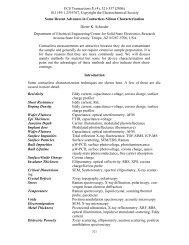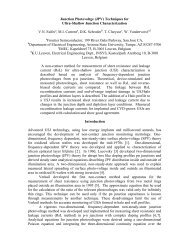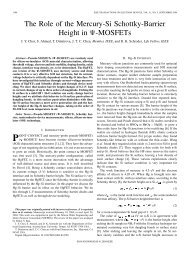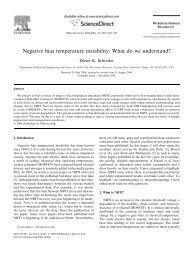Surface voltage and surface photovoltage - Dieter Schroder ...
Surface voltage and surface photovoltage - Dieter Schroder ...
Surface voltage and surface photovoltage - Dieter Schroder ...
Create successful ePaper yourself
Turn your PDF publications into a flip-book with our unique Google optimized e-Paper software.
D K <strong>Schroder</strong><br />
As is obvious from the boundary condition in the detailed<br />
derivation in appendix A, s 1 is the <strong>surface</strong> recombination<br />
velocity at the edge of the space-charge region, i.e., at x = W ,<br />
not at the <strong>surface</strong>. The <strong>surface</strong> recombination velocity at the<br />
<strong>surface</strong> is s r as illustrated in figure 9.<br />
The excess carrier density at x = W is related to the<br />
<strong>surface</strong> <strong>voltage</strong> by the ‘law of the junction’ from pn junction<br />
theory<br />
n(W ) = n 0 (exp(qV S /kT) − 1) ≈ n 0 qV S /kT (18)<br />
for V S ≪ kT/q. The <strong>surface</strong> <strong>voltage</strong> is equal to the probe<br />
<strong>voltage</strong>, giving<br />
V P = kT (1 − R) L n<br />
q n 0 (s 1 + D n /L n ) (L n +1/α) . (19)<br />
The dimensions are shown approximately to scale in figure 10.<br />
Optically generated excess carriers diffuse <strong>and</strong> recombine.<br />
Because the electron <strong>and</strong> hole diffusion coefficients or<br />
mobilities differ, a Dember <strong>voltage</strong> is developed as a result<br />
of this mobility difference, given by [27]<br />
V b = kT (<br />
)<br />
(b − 1)<br />
q (b +1) ln (b +1)n<br />
1+ (20)<br />
n 0 + bp 0<br />
where b = µ n /µ p , with µ n <strong>and</strong> µ p the electron <strong>and</strong> hole<br />
mobilities. For p-type Si with b ≈ 3, p 0 ≫ n 0 <strong>and</strong> room<br />
temperature, equation (20) becomes<br />
(<br />
V b = 0.013 ln 1+ 4n )<br />
≈ 0.013 4n . (21)<br />
3p 0 3p 0<br />
With n/p 0 typically 10 −6 –10 −4 , V b ≈ 1.7 × 10 −8 –1.7<br />
×10 −6 V, a <strong>voltage</strong> that is low compared to the <strong>surface</strong><br />
photo<strong>voltage</strong> <strong>and</strong> is usually neglected.<br />
V S is proportional to n(W) for V S < 0.5kT/q. Typical<br />
<strong>surface</strong> photo<strong>voltage</strong>s are in the low millivolt range, ensuring<br />
a linear relationship. D n <strong>and</strong> L n are assumed to be constant<br />
<strong>and</strong> over a restricted wavelength range, the reflectivity R can<br />
also be considered constant for bare <strong>surface</strong>s. The <strong>surface</strong><br />
recombination velocity s 1 is usually unknown. However, if<br />
n(W ) is held constant during the measurement, the <strong>surface</strong><br />
potential is also constant, <strong>and</strong> s 1 can be considered reasonably<br />
constant. This leaves α <strong>and</strong> as the only variables.<br />
There are two implementations of the SPV method:<br />
(1) constant <strong>surface</strong> photo<strong>voltage</strong> <strong>and</strong> (2) constant photon flux<br />
density. In method (1), V P is held constant, implying n(W)<br />
is also constant. A series of different wavelengths is selected<br />
during the measurement with each wavelength providing a<br />
different α. The photon flux density is adjusted for each<br />
wavelength to hold V P constant, allowing equation (19) to be<br />
written as<br />
= n 0V P (s 1 + D n /L n ) (L n +1/α)<br />
= C 1 (L n +1/α) (22)<br />
(kT /q)(1 − R) L n<br />
where C 1 is a constant.<br />
Then is plotted against 1/α for constant V P . The<br />
result is a line whose extrapolated intercept on the negative<br />
1/α axis ( = 0) is the minority carrier diffusion length L n ,<br />
as shown in figure 11(a). The slope of such a plot is C 1 ,<br />
containing the <strong>surface</strong> recombination velocity s 1 . While it<br />
W ≈ 0.5 µm<br />
1/α (λ = 0.8 µm)<br />
1/α (λ = 1.04 µm)<br />
L n<br />
(τ r<br />
= 100 µs)<br />
0 100 200 300 400 500 600 700 x (µm)<br />
Figure 10. Cross section showing the various lengths for a 675 µm<br />
thick p-type wafer.<br />
Φ (normalized)<br />
1/V P<br />
(normalized)<br />
1<br />
0.8<br />
0.6<br />
0.4<br />
L n<br />
0.2<br />
s 1<br />
= 1000 cm/s<br />
0<br />
-50 0 50 100 150 200<br />
1<br />
0.8<br />
0.6<br />
0.4<br />
0.2<br />
L n<br />
1/α (µm)<br />
(a)<br />
s 1<br />
= 1000 cm/s<br />
0<br />
-50 0 50 100 150 200<br />
1/α (µm)<br />
Figure 11. Normalized SPV plots for (a) constant <strong>surface</strong><br />
photo<strong>voltage</strong> (theory) <strong>and</strong> (b) constant photon flux density (points:<br />
data, lines: theory).<br />
(b)<br />
is difficult to extract s 1 from the other parameters contained in<br />
C 1 , it is possible to observe changes in s 1 by comparing SPV<br />
plots before <strong>and</strong> after a <strong>surface</strong> treatment that changes <strong>surface</strong><br />
recombination.<br />
For the constant photon flux density implementation, we<br />
write equation (19) as<br />
1<br />
= n 0(s 1 + D n /L n ) (L n +1/α)<br />
= C 2 (L n +1/α) (23)<br />
V P (kT /q)(1 − R) L n<br />
where C 2 is a constant. A plot of 1/V P (normalized) versus<br />
1/α gives L n as illustrated in figure 11(b), where both<br />
experimental data <strong>and</strong> theory are shown. V P changes during<br />
the measurement, hence <strong>surface</strong> recombination may vary<br />
during the measurement. However, the <strong>surface</strong> photo<strong>voltage</strong><br />
variation is small <strong>and</strong> variations in <strong>surface</strong> recombination<br />
velocity are likely to be negligible.<br />
The condition W ≪ L n is generally satisfied for singlecrystal<br />
Si, but not necessarily for other semiconductors. For<br />
example, the diffusion length in GaAs is often only a few<br />
microns because radiative recombination dominates. Hence,<br />
diffusion length measurements, primarily used for Si to<br />
determine recombination centre densities, are less important<br />
R22








